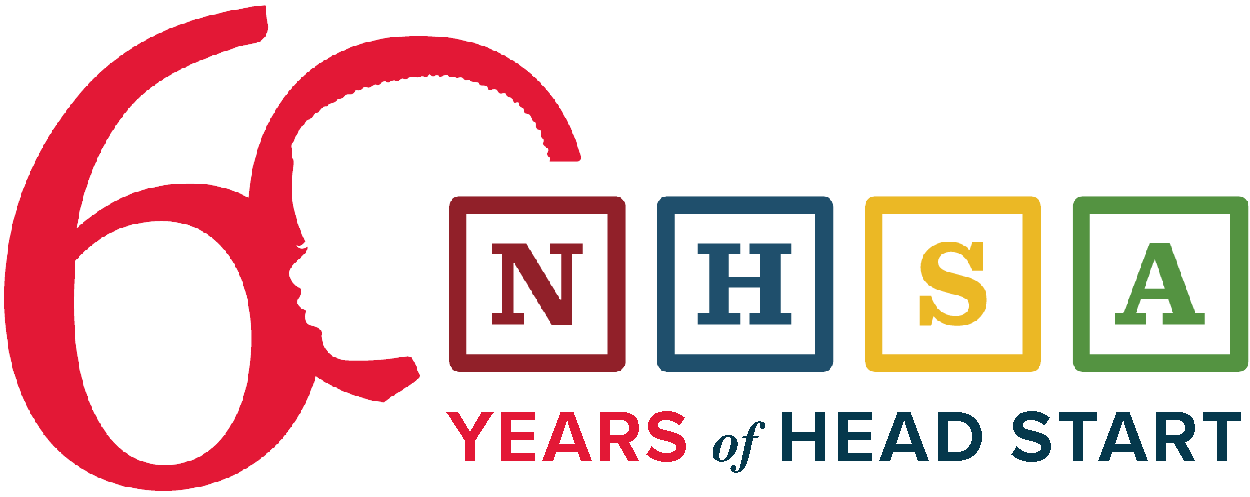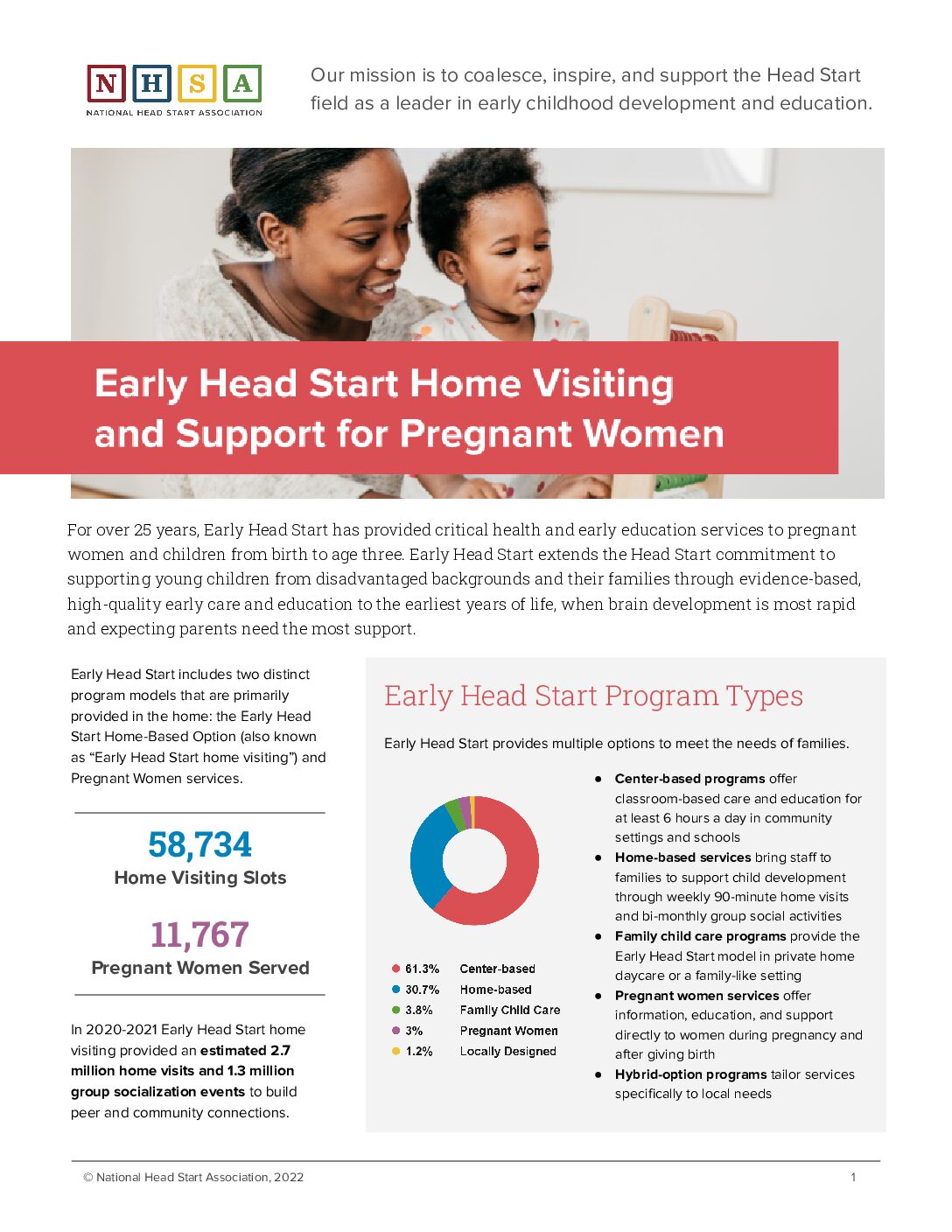Early Head Start home visiting provides services in the home to vulnerable children and families, connecting pregnant women and their families to prenatal care, fostering strong parent-child relationships, and supporting the role of parents as their children’s first and primary teachers. One-third of all Early Head Start slots are designated home-visiting or prenatal services.
Early Head Start home visitors are literally superheroes to those in the preparing to welcome a child and through the throes of caring-for-a-newborn-life. They work to assess and meet the needs of expecting mothers, increase access to postpartum care, promote breastfeeding, support safe and enriching home environments, conduct child developmental screenings, educate families, and provide or connect families to medical, dental, and mental health care as well as adult education and job training opportunities. Roughly half of all Early Head Start home visitors have a Bachelor’s degree, 90% have a Home Visitor Child Development Certificate, and over one-third have five or more years of experience.
The recommended reauthorization of the MIECHV program highlights the importance of quality programs. Early Head Start is proud to be one of MIECHV’s approved evidence-based models. Download the full brief and learn more about their important work.
Fact Sheet Citations
- U.S. Dept. of Health & Human Services Administration for Children & Families. (2022). Program Information Report. ECLKC. https://eclkc.ohs.acf.hhs.gov/data-ongoing-monitoring/article/program-information-report-pir.
- Head Start Regulations Related to the Home-based Option. ECLKC. (2022). Retrieved 28 July 2022, from https://eclkc.ohs.acf.hhs.gov/programs/article/head-start-regulations-related-home-based-option.
- Costs of Evidence-Based Early Childhood Home Visiting: Results from the Mother and Infant Home Visiting Program Evaluation. Administration for Children & Families. (2022). Retrieved 28 July 2022, from https://www.acf.hhs.gov/opre/report/costs-evidence-based-early-childhood-home-visiting-results-mother-and-infant-home.
- Services to Pregnant Women and Expectant Families in Early Head Start. National Center on Parent, Family, and Community Engagement. (2018). Retrieved 1 August 2022, from https://eclkc.ohs.acf.hhs.gov/sites/default/files/pdf/no-search/service-to-pregnant-woman-families.pdf.
- Jones, C., Shah, H., & Xue, Y. (2022). Snapshot of the 2018 Early Head Start Workforce: Who Are the Teachers and Home Visitors Serving Children and Families? OPRE Report 2022-116. Office of Planning, Research, and Evaluation, Administration for Children and Families, U.S. Department of Health and Human Services. Retrieved from https://www.acf.hhs.gov/sites/default/files/documents/opre/bfaces_2018_workforce_june2022.pdf.
- Research on Home Visiting Programs. ECLKC. (2021). Retrieved 1 August 2022, from https://eclkc.ohs.acf.hhs.gov/program-planning/home-visitor-supervisors-handbook/research-home-visiting-programs.
- Xue, Y., Baxter, C., Jones, C., Shah, H., Caronongan, P., Aikens, N., Bandel, E., Cannon, J., Schellenberger, K., Defnet, A., Vogel, C., and Atkins-Burnett, S. (2021). Early Head Start Programs, Staff, and Infants/Toddlers and Families Served: Baby FACES 2018 Data Tables. OPRE Report 2021-92. Office of Planning, Research, and Evaluation, Administration for Children and Families, U.S. Department of Health and Human Services. Retrieved 1 August 2022, from https://www.acf.hhs.gov/opre/report/early-head-start-programs-staff-and-infants/toddlers-and-families-served-baby-faces.
- Administration for Children and Families, U.S. Department of Health and Human Services. (2016). Early Head Start Home-Based Option Meets HHS Criteria. Retrieved from https://homvee.acf.hhs.gov/effectiveness/Early%20Head%20Start%20Home-Based%20Option/In%20Brief.
- National Home Visiting Resource Center. (2022). Retrieved 1 August 2022, from https://nhvrc.org/about-home-visiting/why-home-visiting/#:~:text=Pregnant%20participants%20are%20more%20likely,cognitive%20development%20and%20child%20health.
- National Head Start Association. (2022). Early Head Start Facts and Figures. Retrieved 1 August 2022, from https://nhsa.org/resource/early-head-start-facts-figures/.
- Office of Head Start. (2022). Early Head Start Services Snapshot 2020-2021. Retrieved 1 August 2022, from https://eclkc.ohs.acf.hhs.gov/sites/default/files/pdf/no-search/service-snapshot-ehs-2020-2021.pdf.
- Requirements of the Home-Based Option. ECLKC. (2022). Retrieved 1 August 2022, from https://eclkc.ohs.acf.hhs.gov/program-planning/home-visitors-online-handbook/requirements-home-based-option.
- MIECHV Program. (2021). Retrieved 1 August 2022, from https://mchb.hrsa.gov/programs-impact/programs/home-visiting/maternal-infant-early-childhood-home-visiting-miechv-program.
- Roggman, L., Boyce, L., & Cook, G. (2009). Keeping Kids on Track: Impacts of a Parenting-Focused Early Head Start Program on Attachment Security and Cognitive Development. Early Education and Development, 20(6), 920-941. https://doi.org/10.1080/10409280903118416.
- Health Resources & Services Administration Maternal & Child Health. (2021). The Maternal, Infant, and Early Childhood Home Visiting Program [Ebook]. Retrieved 1 August 2022, from https://mchb.hrsa.gov/sites/default/files/mchb/about-us/program-brief.pdf.
- Monahan, S., Thomas, J., Paulsell, D., & Murphy, L. (2015). Learning About Infant and Toddler Early Education Services (LITES): A Systematic Review of the Evidence. U.S. Department of Health and Human Services, Office of the Assistant Secretary for Planning and Evaluation. Retrieved from https://aspe.hhs.gov/sites/default/files/migrated_legacy_files/142136/LITESsystematic.pdf.

